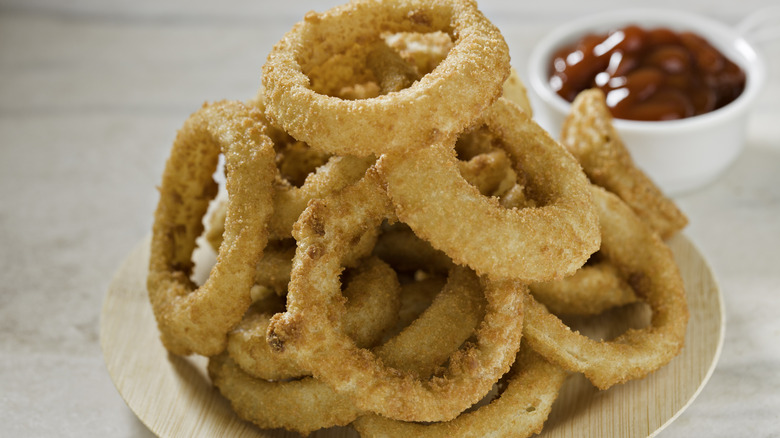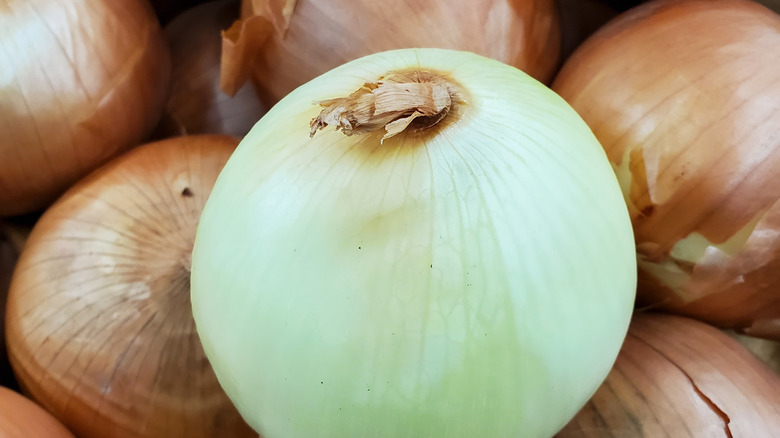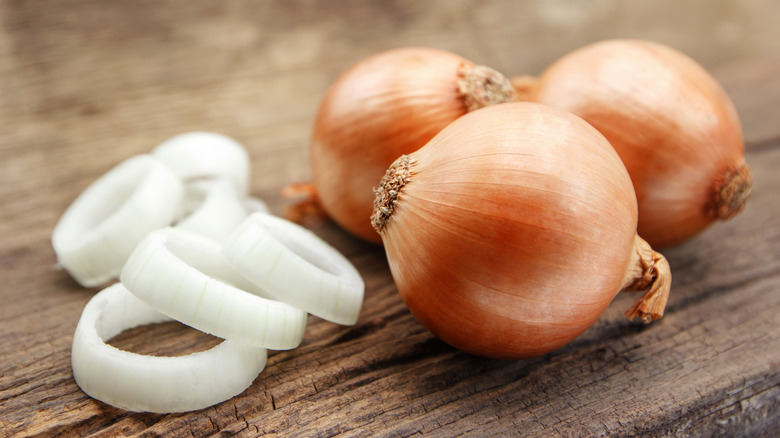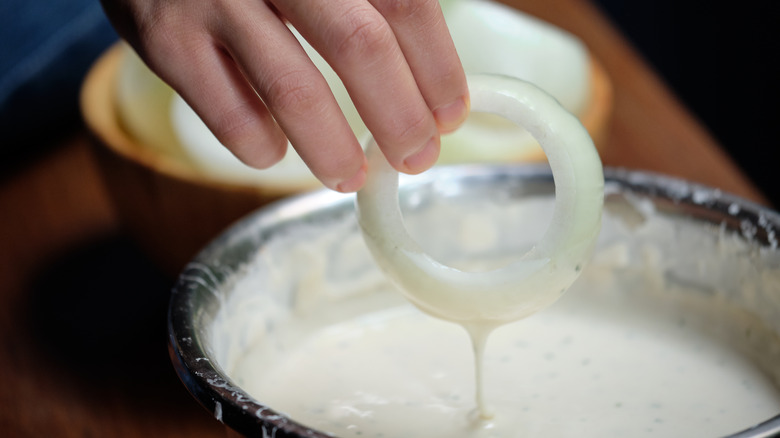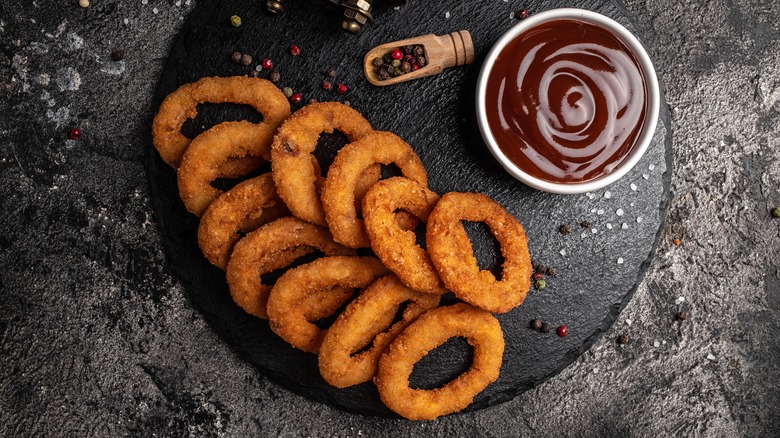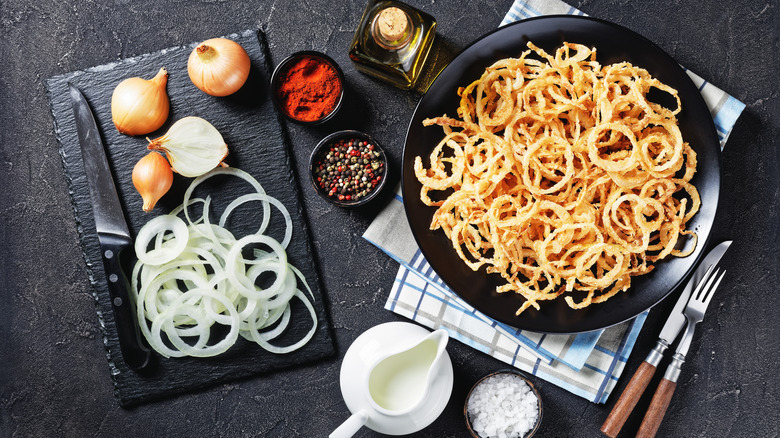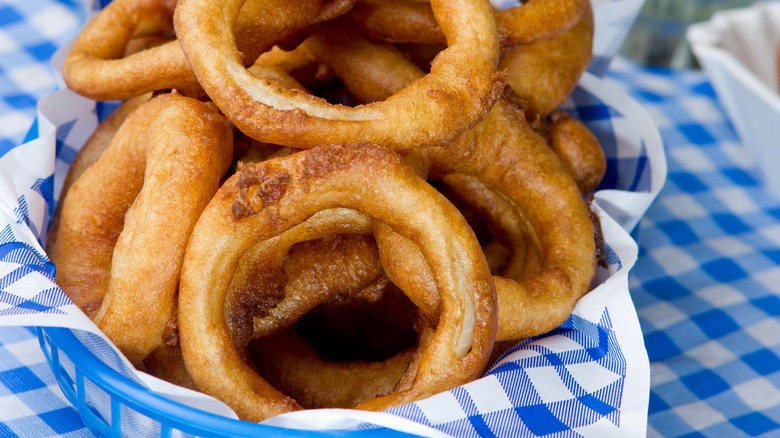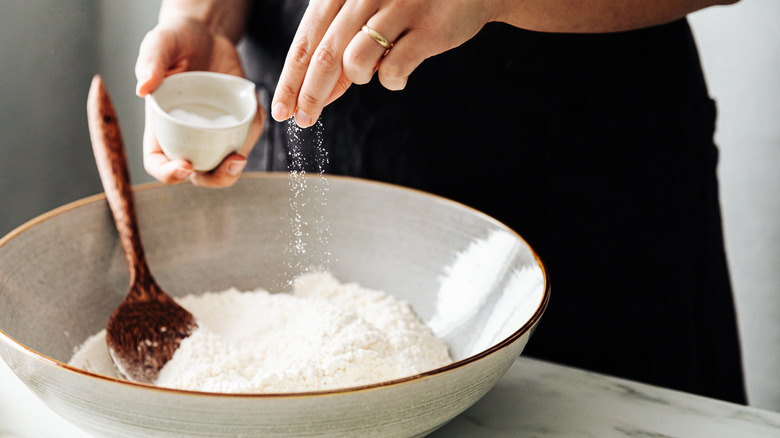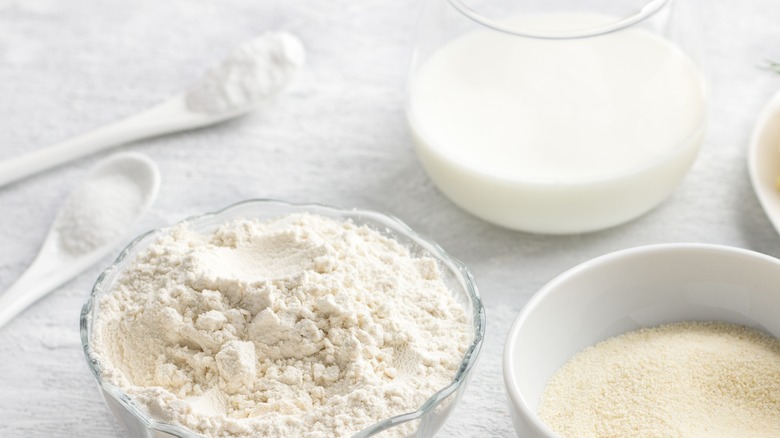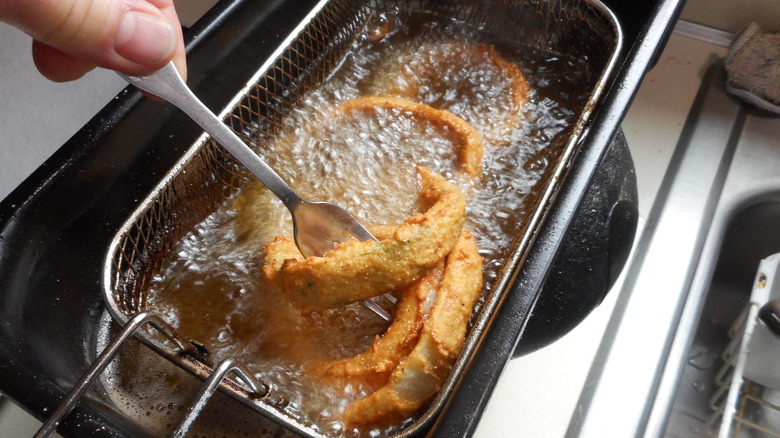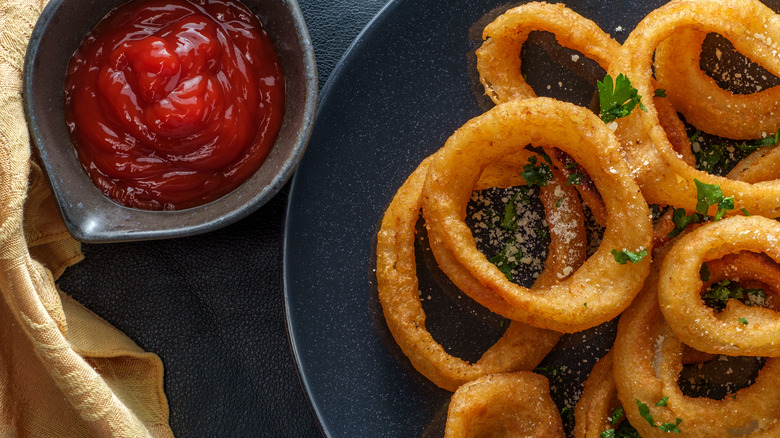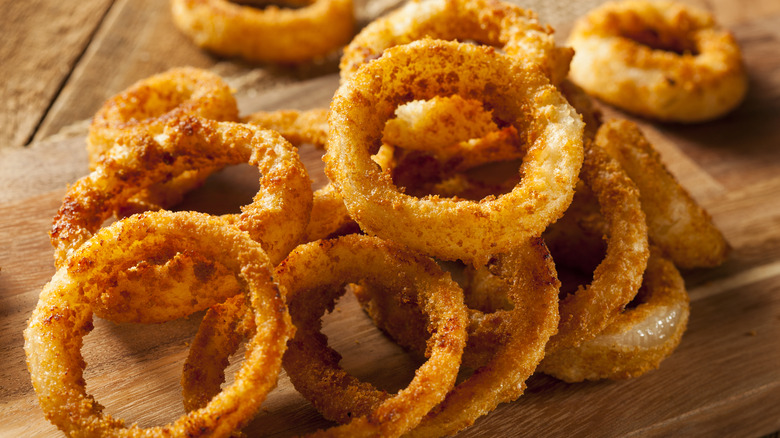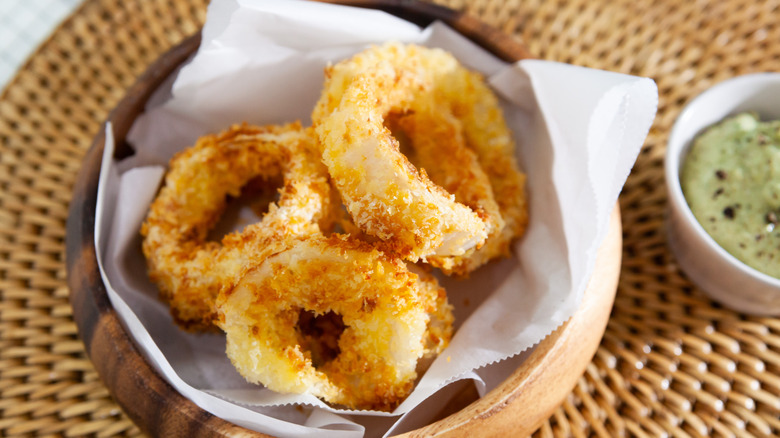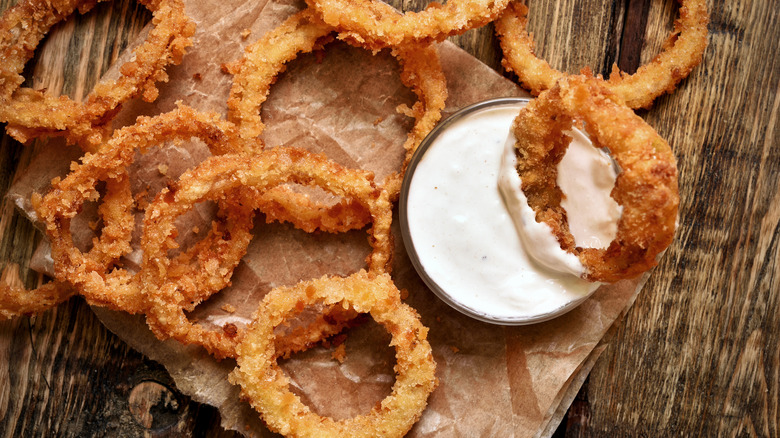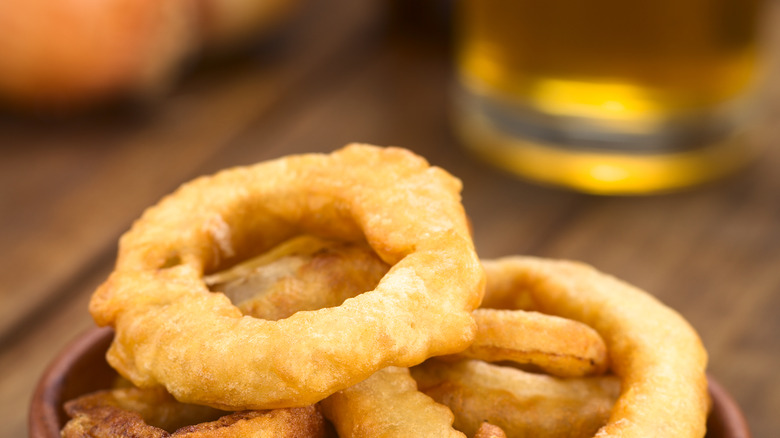14 Tips You Need To Make The Best Onion Rings
Love 'em or hate 'em, onion rings can be a bit of a polarizing indulgence. While certainly, part of the reason they'll always play second fiddle as a fried side dish to French fries is that not everyone loves the bite of an onion, the other part is that they're hard to get right. Soggy onion rings, or those that lose all their breading, or those that lack flavor or are cut too thin or too fat — personal preference and poor craftsmanship can play a role in ruining the treat.
This is why if you're on a mission to make great onion rings, you need tips that go beyond the status quo. Done right, onion rings are the perfect accompaniment to a burger (stacked on top or served alongside), a steak, or fried fish. You can even use them to top baked potatoes and soups or in place of fried onion strips on a homemade green bean casserole. To get the formula right, you need insights from true onion ring connoisseurs. Here, we conferred with some of the country's best onion ring chefs to share their tips on how to make onion rings the right way, so you can get the perfect crunch, flavor, and bite every single time.
Use Spanish onions and keep the centers
According to Black Tap Craft Burgers and Beer's Corporate Chef, Stephen Parker, the perfect onion ring has to start with the right onion. "At Black Tap we use Spanish onions for our onion rings because they pack a nice sweet, mild flavor that is versatile and great for other uses as well," he says. Their size lends itself to various uses — Spanish onions are large enough that the outer rings are perfectly sized for onion rings, but they still have enough onion at the center to do double-duty for other dishes. "Since we can only use the rings for the onion rings, we use the middle of the remaining Spanish onion for our caramelized onion burger topping and other applications," Parker explains.
So the next time you slice up your Spanish onions to fry up a batch of rings, don't try to batter and fry every last bit of the onion. Instead, separate the outer rings from the inner section and store the inside portion in your fridge for later use.
Slice them at least an inch thick
One hotly debated factor when it comes to onion rings is what size is the right size. To be fair, this largely comes down to personal preference. Some people love thin and crispy onion rings that end up having a higher breading-to-onion ratio, while other people prefer wide-cut rings that allow for more onion flavor. As a kind of "middle road" between the two extremes, most onion rings end up around 1/2- to 3/4-inch thick, but Parker argues they should be thicker. "Our onion rings are always an inch or thicker! We love thick onion rings at Black Tap,"
With extra thick onion rings comes a lot of onion flavor, making them the perfect addition to a fancy burger stacked high with toppings. In fact, this is exactly what Black Tap does with their onion rings, as two of their famous burgers — The Texan and The Mexico City — feature the oversized fried onions.
Marinate them in buttermilk
You may have heard that you should soak your onions in cold water or buttermilk before frying them. This helps neutralize the flavor and takes some of the "edge" off, leaving you with a sweeter, crispier onion ring. But Parker takes his soak a step further and full-on marinates the onions before frying. "My favorite tip for a perfect, crispy onion ring is to marinate the onions in buttermilk before dredging them in flour. This step provides an extra layer of moisture that allows the flour to cling and results in a great fry," he says.
And his marinating time isn't just a quick 15 or 20 minutes — he marinates them overnight or for at least six hours. You might think marinating the onions for this long would also affect their flavor, but Parker says that's not the case. It really just enables the flour to stick better and for the batter to get crispier while frying.
Use pre-baked flour for extra crunch
When it comes to perfecting your onion rings, every single step matters, and quite possibly the most important step of all? Getting the batter and breading right. Most recipes call for some combination of flour, breadcrumbs, seasonings, and perhaps baking powder or cornstarch, but Parker says the key to Black Tap's breading is the type of flour used. "We recommend using a good-quality pre-baked flour to make sure there is a strong and flavorful crunch," he says.
Pre-baking flour has a couple of benefits. For one thing, many bakers believes this process kills any bacteria that may be lingering in the raw flour. Considering that onion rings end up being fried at high temperatures, this isn't a major reason to take the time to bake the flour first. But the second reason (and the more important one, in this circumstance) is that baking, cooking, or toasting flour before putting it to use releases a nuttier flavor from the ingredient. It's easy to do — simply cook the flour in a pan over medium heat, whisking constantly, for up to 10 minutes. The longer your cook it, the darker and deeper the flavor becomes. Simply try it out to see if the results give the "strong and flavorful crunch" that Parker promises.
Season immediately after frying
There are a few different theories when it comes to seasoning your onion rings, and we'll cover a couple of them here, but Parker insists that the seasoning should be kept simple, straightforward, and done immediately after frying. "We make sure to season the rings as soon as they come out of the fryer when they are nice and hot. We only season with kosher salt, and adding it right after they're out of the fryer ensures the salt sticks to the outside and makes for a perfectly seasoned final product," he explains.
If you like to keep your onion rings free of excessive seasonings, kosher salt is a good way to go because it doesn't contain the additives that are often found in other salts. The larger flakes are also helpful in that you have a better feel for how much salt you're adding to each ring, and you're less likely to over-salt the batch.
Double batter them with buttermilk and flour
If you have a special penchant for particularly crispy onion rings, you may want to start using this tip from Charles Lee, the co-owner of The Mason Jar by Fatboys Restaurant in Charleston, South Carolina. He swears the key to their often raved-about onion rings is that they double batter them with buttermilk and flour.
Double battering is just what it sounds like — first, the onions are dipped in buttermilk, then in flour, then in buttermilk again, followed by another dip in the flour before they're placed in the fryer. This double dipping helps ensure an even coating of batter and also a thicker coating of batter, which leads to Lee's reasoning for taking the extra step: "Keeps 'em crispy," he says. And clearly, the restaurant is doing something right when it comes to their onion rings, and they (like Black Tap), have made at least one list for best onion rings in America.
Season the flour with salt and pepper before battering
One big difference between Parker's approach to making onion rings and Lee's approach comes down to seasoning. While Parker seasons the rings as soon as they come out of the fryer, Lee says the best time to season is beforehand. In fact, he doesn't season the finished onion rings at all. "[We] season the flour with salt and pepper before battering," he says.
And if you think about it, it's a smart move, especially considering the fact that he double-batters the onions for an extra thick, crispy breading. By seasoning the flour before dipping the onions in it, he's ensuring that the finished batter will have an even amount of salty, peppery flavor all the way through.
Like Parker, Lee's seasoning approach is simple, although he does use a combo of salt and pepper rather than just salt. But if you wanted to get creative with other seasonings — maybe add some garlic or Cajon flavor in there — the approach is the same. Simply add the seasonings to the flour and mix well before you dip the onion rings in.
Use semolina with the flour helps increase the crispiness
Double battering or using pre-baked flour aren't the only ways to ensure an extra crispy onion ring. Felipe Munoz, executive chef at Thompson Hospitality's matchbox Restaurants, is responsible for the brand's signature onion straws. The onion straws may not classify as onion rings, but these super-thin, fried onions are also served as a side dish or piled on top of burgers and require cooking methods that work just as well with classic rings.
And Munoz's tip for getting extra crispy onions? Adding semolina flour to the standard flour before breading the onions. "At matchbox, we make a mix of dry ingredients for the breading. Rather than just using flour, we coat the onion straws in flour, corn starch, and semolina because the three will allow for the most crispy result possible. Semolina specifically helps with the crispiness because it does not retain oil as much as flour does."
Fry 'em quick and hot
Munoz also says it's important to fry the onions quickly and at a high temperature for the best results. "We fry the onions at 250 degrees for 45 seconds," he specifies. That said, his straws are thinner than standard onion rings, so the frying time and temperature are lower than what you should use for rings (although if you like super-thin onion rings, you can try his method). He also opts for frying them in canola oil, thanks to its neutral flavor and high smoke point, but other vegetable oils would also work.
Generally speaking, for thicker onion rings, you should shoot for a temperature between 350-375 degrees Fahrenheit and a fry time of about 2-3 minutes per side (if you're pan-frying the onions). Just remember that the oil temperature is important, and it's a good idea to use a thermometer to monitor the heat. This is because if you put too many onion rings in the oil at once, the temperature can drop, leading to a longer cook time and, often, less crispy, oily rings. If you're working in batches, make sure you let the oil get back to the starting temperature before you add in more rings, ensuring you get the hottest, fastest cook time possible.
Make the seasoning special with cheese and herbs
Munoz is a testament to the fact that you don't have to keep your seasonings simple when it comes to onion rings. In fact, you should try new herbs out and experiment with combinations to find the perfect flavor combination for you. For Munoz's onion straws, he adds the seasonings shortly after the straws are done frying. "Once they are out of the oil and placed on a wire rack to allow excess oil to drip off, the onions are seasoned with a fine salt, Pecorino Romano cheese, and chopped parsley," he says.
Of course, salt seems to be the prevailing seasoning added to onion rings, but from there? The sky's the limit. You could try cayenne pepper and paprika for extra spice, basil, and oregano for a slightly Italian flavor, or even a little mustard powder for some extra tang. And a little cheese never hurts anything — Pecorino Romano is a good choice, but you can always just pull your trusty Parmesan from the fridge and sprinkle a little on top.
Make keto-friendly onion rings with crushed pork rinds
With the low-carb, high-fat keto diet remaining a popular way to eat, you may think that standard onion rings qualify, thanks to the fact that onions themselves are relatively low in carbs, and deep-frying anything raises the fat content. That said, the batter used to fry onion rings? It's definitively not low-carb, thanks to all-purpose flour, breadcrumbs, semolina, and other common ingredients.
Luckily, it's completely possible to make keto-friendly onion rings. "Almond flour is a popular choice for a keto-friendly batter," says Casey Bumpsteed, a food writer, chef, and the editor of Ceramic Cookware Review. "Some also swear by crushed pork rinds for an extra crunch." Of course, almond flour will add a somewhat nutty flavor to your onion rings that may or may not appeal to your liking, but if you choose to add the pork rinds in place of breadcrumbs, you're likely to taste the salty, umami pork skin more than the almond flour. And together, you'll end up with a crunchy, salty, flavorful snack that can easily fit into a keto-friendly lifestyle.
Use the oven or the air fryer for a healthier version
Deep frying or pan frying onion rings is the standard when it comes to the classic side dish, but if you're trying to watch your calorie or fat intake, it's completely possible to make a healthier version of the snack. Bumpsteed points to two good ways to cut down on the use of oil: bake the onion rings or use an air fryer.
With either method, you prep the onion rings as usual, dipping, seasoning, and battering them as if you're going to fry them. But instead of frying, follow Bumpsteed's methods. "For baking, spray them lightly with cooking oil and bake them in a preheated oven at 450 for around 15 minutes. Turning them halfway through ensures even browning," she says. And for air frying? "Preheat your air fryer, spray the onion rings lightly with oil, and air fry at 400 for about 10 minutes." As with baking, you should turn your air-fried rings halfway through to ensure they cook evenly on both sides.
Cold batter is better than room temperature
When you're whipping up your onion ring batter, you're probably not thinking too much about the batter temperature. After all, why would the temperature of the batter matter? Well, it actually does, and it's important to use a batter that's cold rather than batter that's been mixed and sitting at room temperature. "[Cold batter] helps create more steam when frying, leading to a lighter, crispier texture," Bumpsteed says.
And it's not just "pulled out of the fridge" cold — you want your batter to be ice cold. This means you should use store your liquids in the freezer to chill before making the batter, and you should place the batter back in the freezer to stay cold between uses. You can even use ice cubes to bring the temperature down, or if your batter uses buttermilk or milk, you can make ice from the appropriate liquid before use so you can add ice cubes to the batter without the risk of watering it down.
Use seltzer water instead of beer for the beer-battered effect
In all likelihood, you've heard of beer-battered onion rings. It's a popular battering option for adding flavor and a crispy outer crust to your onion ring recipe. But if you don't like the flavor of beer, or you prefer not to use alcohol in your cooking, you can get the same effect with seltzer water instead. You see, it's the carbonation, not the beer itself, that gives beer-battered onion rings their light, airy, beer-battered effect.
To get the same light and airy effect without the flavor or alcohol found in beer, all you have to do is switch out the beer for another carbonated beverage. Unflavored seltzer water is a clear choice, as you take advantage of the carbonation without the flavor, but you can always experiment with flavored seltzer waters or even sodas. Although, adding a sweet beverage to the batter will certainly alter the end result.
One other thing to keep in mind if you choose to ditch the beer for a different carbonated beverage is that it's a good idea to use cornstarch or baking soda in your batter, as well. Where beer adds acidity that helps limit the development of gluten, keeping the batter crisp rather than chewy, seltzer water doesn't have the same acidity. Adding cornstarch or baking soda (or both) can help you achieve the same crisp finish you know and love.
